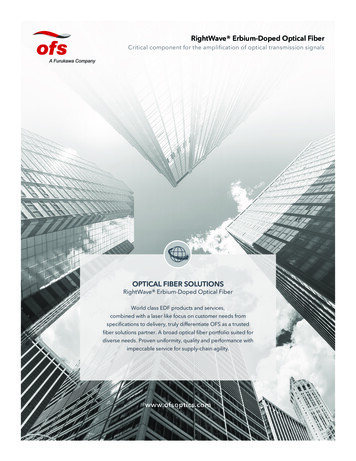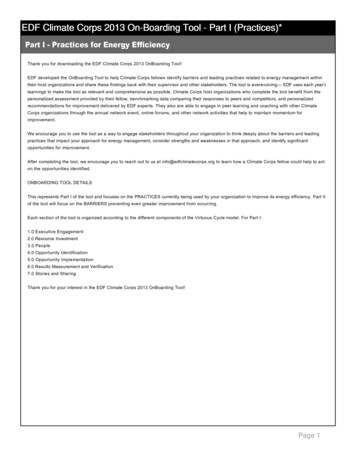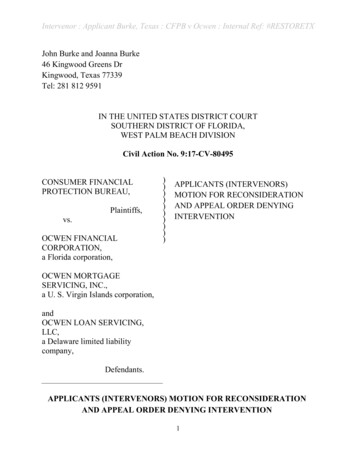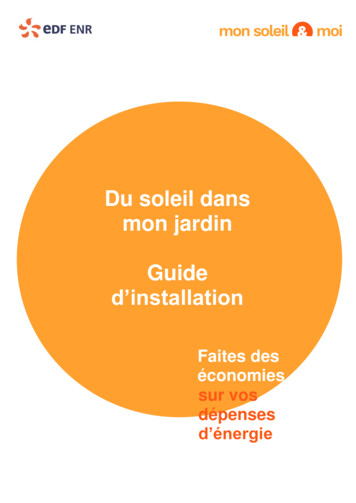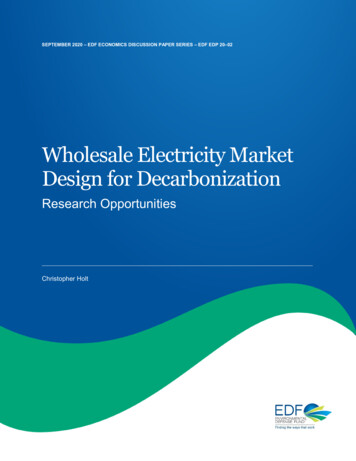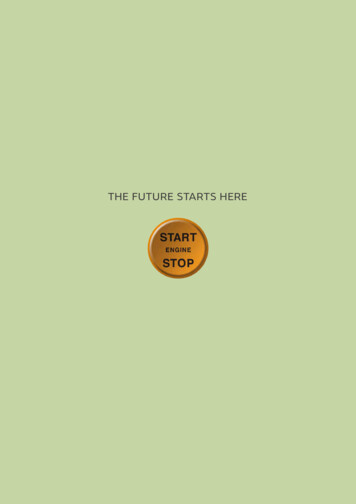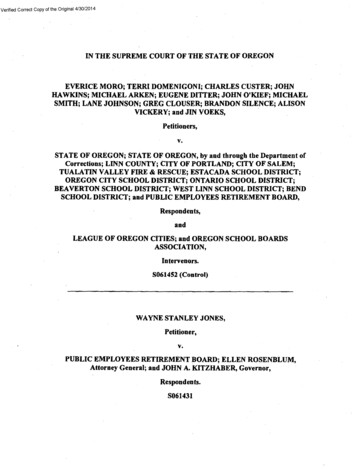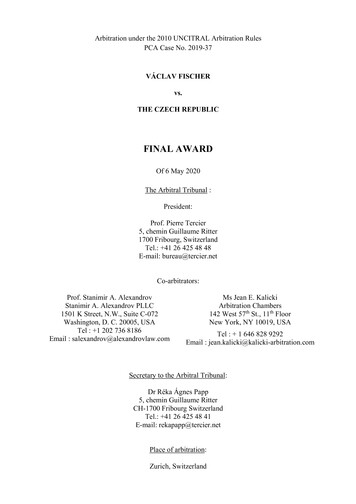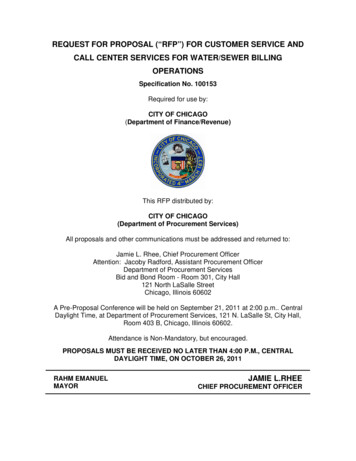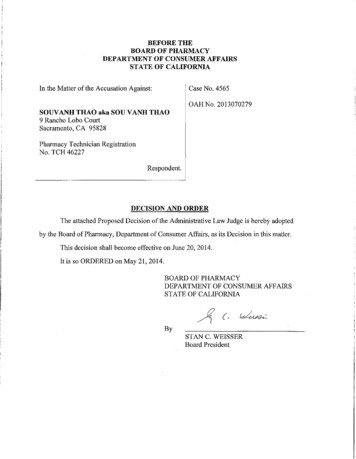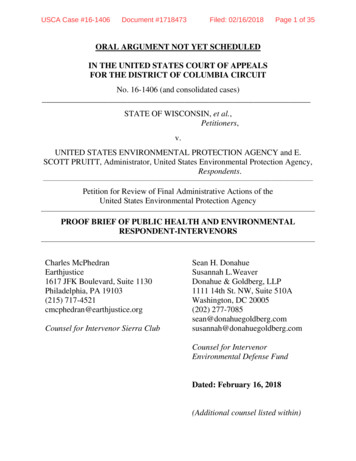
Transcription
USCA Case #16-1406Document #1718473Filed: 02/16/2018Page 1 of 35ORAL ARGUMENT NOT YET SCHEDULEDIN THE UNITED STATES COURT OF APPEALSFOR THE DISTRICT OF COLUMBIA CIRCUITNo. 16-1406 (and consolidated cases)STATE OF WISCONSIN, et al.,Petitioners,v.UNITED STATES ENVIRONMENTAL PROTECTION AGENCY and E.SCOTT PRUITT, Administrator, United States Environmental Protection Agency,Respondents.Petition for Review of Final Administrative Actions of theUnited States Environmental Protection AgencyPROOF BRIEF OF PUBLIC HEALTH AND ENVIRONMENTALRESPONDENT-INTERVENORSCharles McPhedranEarthjustice1617 JFK Boulevard, Suite 1130Philadelphia, PA 19103(215) 717-4521cmcphedran@earthjustice.orgCounsel for Intervenor Sierra ClubSean H. DonahueSusannah L.WeaverDonahue & Goldberg, LLP1111 14th St. NW, Suite 510AWashington, DC 20005(202) ldberg.comCounsel for IntervenorEnvironmental Defense FundDated: February 16, 2018(Additional counsel listed within)
USCA Case #16-1406Document #1718473Neil GormleyDavid BaronHoward FoxEarthjustice1625 Massachusetts Ave., NW, Suite 702Washington, DC 20036(202) ce.orghfox@earthjustice.orgFiled: 02/16/2018Page 2 of 35Graham G. McCahanVickie L. PattonEnvironmental Defense Fund2060 Broadway, Suite 300Boulder, CO 80302(303) 447-7228gmccahan@edf.orgvpatton@edf.orgCounsel for IntervenorEnvironmental Defense FundJoshua R. StebbinsZachary M. FabishSierra Club50 F Street NW, 8th FloorWashington, DC 20001(202) @sierraclub.orgAnn Brewster WeeksClean Air Task Force18 Tremont St., Suite 530Boston, MA 02108(617) 624-0234aweeks@catf.usCounsel for Intervenor Sierra ClubCounsel for Intervenors AmericanLung Association and AppalachianMountain Clubii
USCA Case #16-1406Document #1718473Filed: 02/16/2018Page 3 of 35CERTIFICATE AS TO PARTIES, RULINGS, AND RELATED CASESIn accordance with Circuit Rule 28(a)(1), American Lung Association,Appalachian Mountain Club, Environmental Defense Fund, and Sierra Club(collectively, “Public Health and Environmental Respondent-Intervenors”) herebysubmit this certificate as to parties, rulings, and related cases.(A) Parties, Intervenors and Amici(i) Parties, Intervenors, and Amici Who Appeared in the District CourtThis case is a petition for review of final agency action, not an appeal fromthe ruling of a district court.(ii) Parties to This CasePetitioners:16-1406 – State of Wisconsin, State of Alabama, State of Arkansas, State ofOhio, State of Wyoming16-1428 – State of Texas and Texas Commission on Environmental Quality16-1429 – Murray Energy Corporation16-1432 – Western Farmers Electric Cooperative16-1435 – Utility Air Regulatory Group16-1436 – Midwest Ozone Group16-1437 – Indiana Energy Association and Indiana Utility Group16-1438 – City of Ames, Iowaiii
USCA Case #16-1406Document #1718473Filed: 02/16/2018Page 4 of 3516-1439 – Luminant Generation Company, LLC; Big Brown PowerCompany, LLC; Luminant Mining Company, LLC; La FronteraHoldings, LLC; Oak Grove Management Company, LLC;Sandow Power Company, LLC16-1440 – Mississippi Power Company16-1441 – The Ohio Utility Group; AEP Generation Resources, Inc.;Buckeye Power, Inc.; The Dayton Power and Light Company;Duke Energy Ohio, Incorporated; Dynegy Commercial AssetManagement, LLC; First Energy Solutions; Ohio Valley ElectricCorporation16-1442 – Wisconsin Paper Council, Wisconsin Manufacturers andCommerce, Wisconsin Industrial Energy Group, Wisconsin CastMetals Association16-1443 – Sierra Club and Appalachian Mountain Club16-1444 – Oklahoma Gas and Electric Company16-1445 – Prairie State Generating Company, LLC16-1448 – State of Delaware Department of Natural Resources &Environmental Control17-1066 – Cedar Falls Utilitiesiv
USCA Case #16-1406Document #1718473Filed: 02/16/2018Page 5 of 35Respondents:The U.S. Environmental Protection Agency (“EPA”) is listed as arespondent in all consolidated cases except case 16-1441. E. Scott Pruitt,Administrator of the U.S. Environmental Protection Agency, is listed as arespondent in all cases except cases 16-1435, 16-1438, 16-1445, 16-1448, and 171066.Intervenors:The following entities have moved to intervene in all consolidated cases:American Lung Association; Appalachian Mountain Club; Environmental DefenseFund; Environmental Committee of the Florida Electric Power CoordinatingGroup, Inc.; and Sierra Club.The following entities have moved to intervene in all consolidated casesexcept cases 16-1443 and 16-1448: State of New York, State of Maryland, State ofNew Hampshire, State of Rhode Island, State of Vermont, and Commonwealth ofMassachusetts.Other intervenors include: Cedar Falls Municipal Utilities; Duke EnergyCarolinas, LLC; Duke Energy Progress, LLC; Environmental Committee of theFlorida Electric Power Coordinating Group, Inc.; Murray Energy Corporation; andUtility Air Regulatory Group.v
USCA Case #16-1406Document #1718473Filed: 02/16/2018Page 6 of 35(iii) Amici in This CaseThe American Thoracic Society filed a motion to participate as amicuscuriae on February 16, 2017. An order was entered granting their participation onMarch 2, 2017.(B) Circuit Rule 26.1 Disclosure of Sierra Club and Appalachian MountainClubSee disclosure statement infra pages vii-ix.(C) Ruling Under ReviewPetitioners seek review of the final action taken by EPA at 81 Fed. Reg74,504 (Oct. 26, 2016), JA , titled “Cross-State Air Pollution Rule Update forthe 2008 Ozone NAAQS.”(D) Related CasesPublic Health and Environmental Respondent-Intervenors are unaware ofany related cases other than the consolidated cases listed above.vi
USCA Case #16-1406Document #1718473Filed: 02/16/2018Page 7 of 35RULE 26.1 DISCLOSURE STATEMENTPursuant to Federal Rule of Appellate Procedure 26.1 and D.C. Circuit Rule26.1, Public Health and Environmental Respondent-Intervenors make thefollowing disclosures:American Lung AssociationNon-Governmental Corporate Party to this Action: American Lung Association(“ALA”).Parent Corporations: None.Publicly Held Company that Owns 10% or More of Party’s Stock: None.Party’s General Nature and Purpose: ALA is a corporation organized and existingunder the laws of Maine. ALA is a national nonprofit organization dedicated to aworld free of lung disease and to saving lives by preventing lung disease andpromoting lung health. ALA’s Board of Directors includes pulmonologists andother health professionals.Appalachian Mountain ClubNon-Governmental Corporate Party to this Action: Appalachian Mountain Club.Parent Corporations: None.Publicly Held Company that Owns 10% or More of Party’s Stock: None.Party’s General Nature and Purpose: Appalachian Mountain Club is a regionalnonprofit organization representing more than 90,000 members in the Eastern U.S.vii
USCA Case #16-1406Document #1718473Filed: 02/16/2018Page 8 of 35The organization promotes getting people outdoors for safe and healthy recreationand works to protect the health of the landscapes and waterways of the Northeast.Environmental Defense FundNon-Governmental Corporate Party to this Action: Environmental Defense Fund.Parent Corporations: None.Publicly Held Company that Owns 10% or More of Party’s Stock: None.Party’s General Nature and Purpose: EDF, a corporation organized and existingunder the laws of the State of New York, is a national nonprofit organization thatlinks science, economics, and law to create innovative, equitable, and costeffective solutions to society’s most urgent environmental problems.Sierra ClubNon-Governmental Corporate Party to this Action: Sierra Club.Parent Corporations: None.Publicly Held Company that Owns 10% or More of Party’s Stock: None.Party’s General Nature and Purpose: Sierra Club is a national nonprofitenvironmental organization with more than 667,000 members nationwide. SierraClub’s purposes are to explore, enjoy, and protect the wild places of the Earth; topractice and promote the responsible use of the Earth’s ecosystems and resources;to education and enlist humanity in the protection and restoration of the quality ofviii
USCA Case #16-1406Document #1718473Filed: 02/16/2018Page 9 of 35the natural and human environment; and to use all lawful means to carry out theseobjectives.ix
USCA Case #16-1406Document #1718473Filed: 02/16/2018Page 10 of 35TABLE OF CONTENTSCERTIFICATE AS TO PARTIES, RULINGS, AND RELATED CASES . iiiRULE 26.1 DISCLOSURE STATEMENT. viiTABLE OF AUTHORITIES . xiGLOSSARY OF ACRONYMS AND ABBREVIATIONS. xiiiSTATUTES AND REGULATIONS .1BACKGROUND .1SUMMARY OF ARGUMENT .7ARGUMENT .8I.THE INTERNATIONAL AIR POLLUTION PROVISION CITEDBY INDUSTRY PETITIONERS DOES NOT EXCUSE STATESFROM THEIR GOOD NEIGHBOR OBLIGATIONS .8II.INDUSTRY PETITIONERS’ “OVER-CONTROL” ARGUMENTBASED ON INCIDENTAL REDUCTIONS FROM “UNLINKED”STATES LACKS MERIT .11III.UPWIND STATE PETITIONERS’ CLAIMS ABOUT BIOGENICEMISSIONS ARE WAIVED AND MERITLESS. .14IV.IF THE COURT SUSTAINS ANY OF THE UPWIND STATES’CHALLENGES, IT SHOULD REMAND THE RULE TO EPAWITHOUT VACATUR .16CONCLUSION .19CERTIFICATE OF COMPLIANCE .21CERTIFICATE OF SERVICE .22x
USCA Case #16-1406Document #1718473Filed: 02/16/2018Page 11 of 35TABLE OF AUTHORITIESCases . Page(s)Allied-Signal, Inc. v. U.S. Nuclear Reg. Comm’n,988 F.2d 146 (D.C. Cir. 1993) . 17Appalachian Power Co. v. EPA,249 F.3d 1032 (D.C. Cir. 2001) . 16Catawba Cnty. v. EPA,571 F.3d 20 (D.C. Cir. 2009) . 9Cement Kiln Recycling Coal. v. EPA,255 F.3d 855 (D.C. Cir. 2001) . 14CTS Corp. v. EPA,759 F.3d 52 (D.C. Cir. 2014) . 10EME Homer City Generation, L.P. v. EPA,795 F.3d 118 (D.C. Cir 2015) (“Homer City II”) .11, 12, 13, 17, 19EPA v. EME Homer City Generation, L.P.,134 S. Ct. 1584 (2014) (“EME Homer City”) .2, 3, 11, 14Georgia v. Tenn. Copper Co.,206 U.S. 230 (1907) . 2Miss. Comm’n on Envtl. Quality v. EPA,790 F.3d 138, 163 & n.12 (D.C. Cir. 2015). 10Mississippi v. EPA,744 F.3d 1334 (D.C. Cir. 2013) . 18Nat’l Ass’n of Clean Water Agencies v. EPA,734 F.3d 1115 (D.C. Cir. 2013) . 18Nat’l Lime Ass’n v. EPA,233 F.3d 625 (D.C. Cir. 2000) . 18xi
USCA Case #16-1406Document #1718473Filed: 02/16/2018Page 12 of 35North Carolina v. EPA,531 F.3d 896 (D.C. Cir.), reh’g granted in part, 550 F.3d 1176(D.C. Cir. 2008) .17, 18Olympic Airways v. Husain,540 U.S. 644 (2004) . 9Sierra Club v. EPA,167 F.3d 658 (D.C. Cir. 1999) . 18Statutes42 U.S.C. §§ 7408-10. 342 U.S.C. § 7410(a)(1) . 942 U.S.C. § 7410(a)(2)(D)(i)(I) . 2, 942 U.S.C. § 7426(b) . 242 U.S.C. § 7509a . 742 U.S.C. § 7509a(a)(1)-(2) . 842 U.S.C. § 7607(d)(7)(B) . 15Regulations40 C.F.R. Pt. 50 . 380 Fed. Reg. 75,706 (Dec. 3, 2015) . 481 Fed. Reg. 74,504 (Oct. 26, 2016). 1, 2, 3, 5, 6, 11, 12, 13, 14, 16xii
USCA Case #16-1406Document #1718473Filed: 02/16/2018Page 13 of 35GLOSSARY OF ACRONYMS AND ABBREVIATIONSPursuant to Circuit Rule 28(a)(3), the following is a glossary of acronymsand abbreviations used in this brief:2016 Transport Rule81 Fed. Reg. 74,504 (Oct. 26, 2016)ActClean Air ActCSAPRCross-State Air Pollution RuleEPAU.S. Environmental Protection AgencyJAJoint AppendixNAAQSNational Ambient Air Quality StandardsNOXNitrogen oxidesRIARegulatory Impact AnalysisVOCVolatile organic compoundsxiii
USCA Case #16-1406Document #1718473Filed: 02/16/2018Page 14 of 35Respondent-Intervenors American Lung Association, Appalachian MountainClub, Environmental Defense Fund, and Sierra Club (“Public Health andEnvironmental Respondent-Intervenors”) respectfully submit this brief in responseto the briefs of Petitioners Utility Air Regulatory Group, et al. (“IndustryPetitioners”) and Wisconsin, et al. (“Upwind State Petitioners”).1STATUTES AND REGULATIONSPertinent statutes and regulations are set out in the addenda to the briefs ofConservation Groups and State of Delaware Petitioners, and Joint IndustryPetitioners.BACKGROUNDThe relevant Clean Air Act (the “Act”) provisions, regulatory history, anddesign of the rule challenged here, the Cross-State Air Pollution Rule (“CSAPR”)Update for the 2008 Ozone National Ambient Air Quality Standards (“NAAQS”),81 Fed. Reg. 74,504 (Oct. 26, 2016) (the “2016 Transport Rule” or “Rule”),JA , are described at pages 3-22 of Respondent Environmental ProtectionAgency’s (“EPA”) brief. We provide brief additional background concerning theRule’s important health and environmental benefits.1Respondent-Intervenors Appalachian Mountain Club and Sierra Club are alsopetitioners and have submitted a brief in that capacity (together with the State ofDelaware).1
USCA Case #16-1406Document #1718473Filed: 02/16/2018Page 15 of 35Interstate pollution poses a distinct challenge in our federal system. UpwindStates may lack incentive to control pollution insofar as it affects their neighbors,and downwind States lack the authority to regulate “persons beyond [their]control,” Georgia v. Tennessee Copper Co., 206 U.S. 230, 238 (1907). Indeed,well over half of ground-level ozone in the Eastern United States is produced byprecursor emissions from upwind states. 81 Fed. Reg. at 74,514, JA . Suchpollution creates both public health and economic harms for downwind states,which may be forced to impose far more stringent, and expensive, controls thanupwind neighbors.Congress enacted, and strengthened, interstate air pollution protections inclean air legislation adopted in 1963, 1970, 1977, and 1990. See EPA v. EMEHomer City Generation, L.P., 134 S. Ct. 1584, 1594-95 (2014) (“EME HomerCity”). The Clean Air Act’s current “Good Neighbor” provision prohibits airpollution that “contribute[s] significantly” to nonattainment of or interferes withmaintenance of air quality standards in downwind states. 42 U.S.C.§ 7410(a)(2)(D)(i)(I); see also id. § 7426(b).Confronting a complex web of interactions between upwind pollution anddownwind air quality problems covering much of the Eastern United States, EPAhas implemented a succession of regional rules to enforce states’ obligations underthe Good Neighbor Provision, which have been subject to legal challenges yielding2
USCA Case #16-1406Document #1718473Filed: 02/16/2018Page 16 of 35comprehensive judicial opinions. See EME Homer City, 134 S. Ct. at 1594-97. Inthe 2016 Transport Rule, EPA implemented Good Neighbor requirements, thistime in pursuit of attainment of the 2008 ozone standard.Ground-level ozone, also known as smog, a pollutant regulated under theClean Air Act (see 42 U.S.C. §§ 7408-10; 40 C.F.R. Pt. 50), develops whennitrogen oxides (“NOX”) mix with volatile organic compounds (“VOCs”) in thepresence of sunlight. Warmer air feeds and speeds its production. Ozone is acaustic pollutant that irritates the lungs, causing shortness of breath and coughing,and exacerbates lung conditions like asthma, causing increased numbers ofemergency room visits and hospitalizations. Exposure to ambient ozone is alsolinked to a wide array of serious heart and lung diseases, as well as prematuredeath. Ozone pollution is particularly harmful for children, seniors, people withlung impairments like asthma and chronic obstructive pulmonary disease, andanyone active outdoors. 81 Fed. Reg. at 74,514, JA .22 EPA, Fact Sheet, Overview of EPA’s Updates to the Air Quality Standards forGround-Level Ozone (Oct. 2015), available 0/documents/overview of 2015 rule.pdf (last visited Feb. 15, 2018); see alsoEPA, Integrated Science Assessment (ISA) of Ozone and Related PhotochemicalOxidants, Final Report (Feb. 2013), available eid 247492#Download (lastvisited Feb. 15, 2018). Recent studies show that ozone and particulate matterassociated with ozone cause even more premature deaths in the elderly, and atlower ambient levels, than was previously understood by EPA at the time the 20163
USCA Case #16-1406Document #1718473Filed: 02/16/2018Page 17 of 35Many of the most populous areas of the country have suffered frompersistent nonattainment of health-protective ozone standards including the 2008ozone standard at issue here. In many areas, this serious and chronic public healthhazard is due, in large part, to the effect of pollutants transported from upwindstates. See 80 Fed. Reg. 75,706, 75,711 (Dec. 3, 2015), JA . By reducingemissions of ozone precursors from power plants located in 22 upwind states, the2016 Transport Rule will reduce exposure to ground-level ozone for millions ofAmericans.Whatever the metric chosen, the 2016 Transport Rule’s public health andenvironmental benefits far exceed the Rule’s costs. Because NOX is a precursorpollutant to both ozone and particulate matter, reducing 22 CSAPR states’ NOXemissions during the ozone season (generally May 1 through September 30)Transport Rule was finalized. See Tony Barboza, “Air pollution exposure mayhasten death, even at levels deemed ‘safe,’ study says,” Los Angeles Times (June28, 2017), available at n-airpollution-death-20170628-story.html (last visited Feb. 15, 2018) (discussing QianDi, et al., “Air Pollution and Mortality in the Medicare Population,” 376 New Eng.J. Med. 2513 (June 2017)); Brian Bienkowski, “‘Safe’ levels? Small amounts of airpollution linked to more death for senior citizens: Study,” Envt’l Health News(Dec. 27, 2017), available at 519387578.html (last visited Feb. 15, 2018) (discussing Qian Di, et al.,“Association of Short-term Exposure to Air Pollution With Mortality in OlderAdults,” 318 JAMA 2446 (Dec. 2017)).4
USCA Case #16-1406Document #1718473Filed: 02/16/2018Page 18 of 35reduces the breathing public’s exposure to ambient ozone and fine particulates.3As EPA describes and evaluates in the final Rule and the Regulatory ImpactAnalysis accompanying it, these ozone and particulate matter reductions meanreduced numbers of premature deaths, many fewer hospitalizations of children andadults due to respiratory illnesses including asthma, fewer cases of childhoodbronchitis and exacerbated asthma, and fewer lost work and school days, amongother human health benefits each year beginning in 2017.4The economic value of some of these public health benefits can bemonetized using well-established, peer-reviewed methodologies. EPA performedthis analysis in its RIA,5 which reports a range of monetized expected public health3See 81 Fed. Reg. at 74,553, tbl. VI.E-2, JA , showing 2015 and final CSAPRUpdate ozone season NOX emissions, which are 20 percent lower overall than the2015 level. The ozone reductions, and the health benefits that accompany them,will also accrue outside the ozone season, as will the particulate matter relatedhealth benefits. The additional NOX reductions outside the ozone season will raisethe total expected NOX reductions to around 75,000 tons. Id. at 74,573, tbl. VIII.1,JA ; EPA, Regulatory Impact Analysis at 5-20, tbl. 5-3, JA (EPA-HQOAR-2015-0500-0580) (Sept. 2016) (“RIA”).481 Fed. Reg. at 74,505, 74,574 & tbls. VIII.3 & VIII.4, JA , -(summarizing the avoided human health effects of exposure to ozone andparticulate matter expected in 2017 from implementation of the Rule, includingamong other benefits, over 60 avoided deaths each year, over 67,000 avoided childasthma exacerbations, over 56,000 avoided missed school days, and over 240emergency room visits for asthma); RIA at 5-5, tbl. 5-1, JA .5RIA, Chapter 5, 5-14 to 5-28, JA - ; see also id. at 5-20, tbl. 5-4, JA(presenting summary of estimated monetized health benefits of the Rule).5
USCA Case #16-1406Document #1718473Filed: 02/16/2018Page 19 of 35benefits values of between 370 million and 610 million annually, reflecting onlybenefits in the 22-state region subject to the Rule’s requirements, and only theozone season ozone-related benefits.6 Other known public health benefits of theRule—for example avoided respiratory illnesses due to exposure to NOX asnitrogen dioxide—cannot be monetized, but are certainly valuable.7The Rule’s reductions in ozone and particulate matter also yield significantenvironmental benefits which EPA does not yet have the tools to monetize. Thesebenefits include, among others, avoided forest and other vegetation damage,visibility gains in national and state parks, and benefits to sensitive ecosystems inlakes, streams, coastal waters, and estuaries.8 The monetized figures for the publichealth and welfare benefits of the Rule as reported in the RIA are thereforeundercounted, and do not represent their full total public value. Yet even the range6RIA at 5-2, JA (reported benefits only those in the 22 state region), 5-20, tbl.5-4, JA (range of benefit values reflects the use of discount rates of 3% and7% in the analysis). Total benefits of the rule, including those associated withNOX as fine particulate matter, are estimated at 460 to 810 million annually, andeven that figure does not include all benefits, only those associated with reducedNOX emissions, and that can be monetized. Id.; EPA Br. 111. EPA also reports 66 million ( 2011) in annual climate co-benefits of the Rule. EPA Br. 111; RIAat 5-39, tbl. 5-9, JA (reporting health benefits and climate co-benefits; 66million is the value EPA chose for its reporting, using a 3% interest rate).7The unquantified benefits of the Rule are summarized in the RIA. RIA at 5-40,tbl. 5-10, JA - ; see also id. at 5-5, tbl. 5-1, JA .881 Fed. Reg. at 74,505, 74,509, 74,514, 74,573-575, 74,581-82, JA , ,, - , - ; RIA at 5-39 to 5-43 & tbl. 5-10, JA - .6
USCA Case #16-1406Document #1718473Filed: 02/16/2018Page 20 of 35of reported monetizable benefits outweighs the 68 million annual cost of the Ruleby factors of 10 or more.SUMMARY OF ARGUMENTAs EPA and New York, et al. (“Downwind State Respondent-Intervenors”)demonstrate, Upwind State and Industry Petitioners’ challenges to the 2016Transport Rule are meritless.Contrary to Industry Petitioners’ argument, a Clean Air Act provisionaddressing nonattainment caused by air pollution originating from outside theUnited States’ borders, 42 U.S.C. § 7509a, does not diminish upwind states’obligations under the Good Neighbor Provision, or call the Rule into question.EPA properly followed the safeguards against “over-control” as set out bythe Supreme Court and this Court. Industry Petitioners’ argument based upon theaggregate avoided pollution contributions from unlinked states misses the mark,and, in any event, Industry Petitioners fail to show that such emissions reductionslead to over-control in any affected state.Upwind State Petitioners’ argument that EPA did not properly account forbiogenic ozone precursors was not raised in comments, and is therefore notproperly before the Court. The argument is meritless in any event.Finally, if any of the Upwind State Petitioners’ claims were sustained, theproper remedy would not be, as they claim, vacatur of the Rule. Rather, given the7
USCA Case #16-1406Document #1718473Filed: 02/16/2018Page 21 of 35Rule’s importance for public health and the disruption that vacatur would entail,the proper remedy would be remand without vacatur.ARGUMENTIndustry and Upwind State Petitioners raise a scattershot array of challengesto the Rule, all of which are answered in EPA’s and Downwind State RespondentIntervenors’ Briefs. We respond briefly to certain of these arguments.I.THE INTERNATIONAL AIR POLLUTION PROVISION CITED BYINDUSTRY PETITIONERS DOES NOT EXCUSE STATES FROMTHEIR GOOD NEIGHBOR OBLIGATIONSSeeking to evade responsibility for the interstate emissions they cause,Industry Petitioners point (Br. 15-17) to international emissions they claim shouldinstead bear responsibility. Industry Petitioners are mistaken. Under the Clean AirAct provision they cite, EPA is required to approve an implementation plan thatmeets all requirements to demonstrate attainment and maintenance of a NAAQSwhere the submitting state establishes to EPA’s satisfaction that the plan would beadequate to attain and maintain the standards but for emissions emanating fromoutside of the United States. 42 U.S.C. § 7509a(a)(1)-(2). But this provision doesnot transform international emissions into an excuse to evade upwind states’statutory Good Neighbor obligations.The focus of section 7509a differs from that of the Good NeighborProvision. While a state’s submission of a plan to “attain and maintain” the8
USCA Case #16-1406Document #1718473Filed: 02/16/2018Page 22 of 35NAAQS can trigger section 7509a, the Good Neighbor Provision does not requirethe upwind state to submit such a plan—i.e., an attainment and maintenance plan—for a downwind state. On the contrary, that is the job of the downwind state itself,under statutory language (“within such State”) quoted in Industry’s own brief (at16, quoting 42 U.S.C. § 7410(a)(1)).Instead, the Good Neighbor Provision requires the upwind state’s plan toprohibit emissions that “contribute” significantly to nonattainment or “interfere”with maintenance in the downwind state. 42 U.S.C. § 7410(a)(2)(D)(i)(I). It doesnot follow that if international emissions do contribute to nonattainment orinterfere with maintenance, then upwind state emissions do not contribute orinterfere. As the Supreme Court has observed, “there are often multipleinterrelated factual events that combine to cause any given injury.” OlympicAirways v. Husain, 540 U.S. 644, 653 (2004). “Indeed, the very fact that multipleevents will necessarily combine and interrelate to cause any particular injurymakes it difficult to define, in any coherent or non-question-begging way, anysingle event as the ‘injury producing event.’” Id. (emphasis in original). Thus, thisCourt has rejected attempts to define “contribute” narrowly, including inenvironmental cases. Catawba Cnty. v. EPA, 571 F.3d 20, 39 (D.C. Cir. 2009)(because “a contribution may simply exacerbate a problem rather than cause it,”pollution is cognizable under the Act’s nonattainment area designation provision9
USCA Case #16-1406Document #1718473Filed: 02/16/2018Page 23 of 35“even though a nearby county’s nonattainment problem would still persist in itsabsence”); Miss. Comm’n on Envtl. Quality v. EPA, 790 F.3d 138, 163 & n.12(D.C. Cir. 2015) (“Indiana protests that there likely would have been no violationat all at the Zion monitor if it were not for the emissions” from Illinois, but “[t]hatargument is merely a rephrasing of the but-for causation rule that we rejected inCatawba County.”); CTS Corp. v. EPA, 759 F.3d 52, 59-60 (D.C. Cir. 2014) (toconclude that a given site contributed to groundwater contamination, EPA did nothave to rule out other potential causes such as septic tanks).In short, emissions from a particular upwind state can—and do—contributeor interfere, even if other emission sources elsewhere do also. As EPA points out,even if a given downwind receptor might attain the NAAQS absent internationalemissions, “[m]any (or perhaps all) receptors would also attain the NAAQS if allin-s
CERTIFICATE AS TO PARTIES, RULINGS, AND RELATED CASES In accordance with Circuit Rule 28(a)(1), American Lung Association, Appalachian Mountain Club, Environmental Defense Fund, and Sierra Club (collectively, "Public Health and Environmental Respondent-Intervenors") hereby submit this certificate as to parties, rulings, and related cases.
